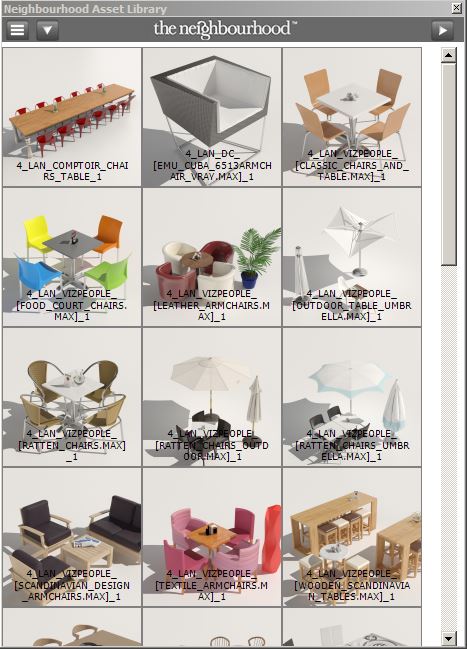Here is a short and sweet blog post on how to create a dotnet form in 3Dsmax. There are a few out there, but I thought It would be good to share the one I use on a daily basis. The best feature of this is the fact that you can drag the UI around. This basically allows it to run like a normal windows UI but with all the nice UI features of dotnet. In the video I have shown how you can quickly adjust the height and width of the UI, and the close button will always align to the top right.
Here is the code below. Hope it helps you out! I'm going to try and add some standard buttons and dropdown as examples over the coming weeks. Almost like a tool kit of how to get started with dotnet. As always any questions just leave a comment below and I will attempt to answer it the best I can.
John
try(dn_form_Tasks.close())catch() Ccolor = dotnetclass "system.drawing.color" Padding = 6 HexFont = dotNetObject "System.Drawing.Font" "Verdana" 10 ((dotNetClass "System.Drawing.FontStyle").bold) fnt_Titles = dotNetObject "System.Drawing.Font" "Myriad Pro Regular" 8 ((dotNetClass "System.Drawing.FontStyle").regular) --Dotnet Colours global TopbarGrey = (dotNetClass "system.drawing.color").fromArgb 73 73 73 BackGrey = (dotNetClass "system.drawing.color").fromArgb 29 29 29 --Form Settings dn_form_Tasks = dotNetObject "MaxCustomControls.MaxForm" fn changeBackcolor = (dn_form_Tasks.backColor = BackGrey) dotnet.AddEventHandler dn_form_Tasks "BackColorChanged" changeBackcolor dn_form_Tasks.AllowTransparency=true dn_form_Tasks.opacity=1 dn_form_Tasks.width=600 dn_form_Tasks.height=200 dn_form_Tasks.FormBorderStyle=(dotNetClass "System.Windows.Forms.FormBorderStyle").none --'Close' Button dn_btn_Close = dotnetObject "system.windows.forms.button" dn_btn_Close.width=35 dn_btn_Close.height=34 dn_btn_Close.top=0 dn_btn_Close.left=(dn_form_Tasks.width-35) dn_btn_Close.flatStyle=(dotNetClass "System.Windows.Forms.FlatStyle").flat dn_btn_Close.backcolor = Ccolor.lightgray dn_btn_Close.forecolor = Ccolor.dimgray dn_btn_Close.font = HexFont dn_btn_Close.text = "x" dn_btn_Close.flatappearance.bordersize = 0 dn_form_Tasks.controls.add dn_btn_Close fn md_btn_Close dn_btn_Close evnt = ( dn_form_Tasks.dispose() ) dotnet.addEventHandler dn_btn_Close "MouseUp" md_btn_Close --Asset ID Label lbl_AssetID = dotNetObject "label" lbl_AssetID.text = "Create Project - Main two" lbl_AssetID.backColor = TopbarGrey lbl_AssetID.Width = dn_form_Tasks.width lbl_AssetID.Height = 23 lbl_AssetID.left = 5 lbl_AssetID.top = 11 lbl_AssetID.forecolor = Ccolor.darkgray dn_form_Tasks.controls.add lbl_AssetID --Shotgun Image TopBar = dotnetobject "Windows.Forms.PictureBox" TopBar.backcolor = TopbarGrey TopBar.width = dn_form_Tasks.width TopBar.height = 35 TopBar.left = 0 dn_form_Tasks.controls.add TopBar global mouseOffset = [0,0] global dragging = 0 fn lbl_AssetIDDown lbl_AssetID evnt = ( mouseOffset[1] = mouse.screenPos.x - dn_form_Tasks.left mouseOffset[2] = mouse.screenPos.y - dn_form_Tasks.top global dragging=1 ) dotnet.addEventHandler lbl_AssetID "MouseDown" lbl_AssetIDDown fn lbl_AssetIDMove lbl_AssetID evnt = ( if dragging==1 then ( local FormPos = #() local NewPos = #() FormPos[1] = dn_form_Tasks.left FormPos[2] = dn_form_Tasks.top NewPos[1] = mouse.screenpos.x - mouseOffset[1] NewPos[2] = mouse.screenpos.y - mouseOffset[2] dn_form_Tasks.left = NewPos[1] dn_form_Tasks.top = NewPos[2] ) ) dotnet.addEventHandler lbl_AssetID "MouseMove" lbl_AssetIDMove fn lbl_AssetIDUp lbl_AssetID evnt = ( global dragging=0 ) dotnet.addEventHandler lbl_AssetID "MouseUp" lbl_AssetIDUp --UI FINISH --Declare and create form dotNet.setLifeTimeControl dn_form_Tasks #dotNet dn_form_Tasks.showModeless() fn getScreenResolution= ( screen = (dotNetClass "System.Windows.Forms.Screen").PrimaryScreen.Bounds return #(screen.Width, screen.Height) ) res = getScreenResolution() ResWidth = (res[1]/2)-(dn_form_Tasks.width/2) ResHeight = (res[2]/2)-(dn_form_Tasks.height/2) dn_form_Tasks.top = ResHeight dn_form_Tasks.left = ResWidth
